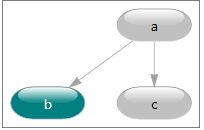Top Qs
Timeline
Chat
Perspective
DGML
From Wikipedia, the free encyclopedia
Remove ads
Directed Graph Markup Language (DGML) is an XML-based file format for directed graphs.[1]
This article relies largely or entirely on a single source. (November 2015) |
Remove ads
Introduction to DGML
Here is what a simple directed graph with three nodes and two links between them looks like
<?xml version="1.0" encoding="utf-8"?>
<DirectedGraph xmlns="http://schemas.microsoft.com/vs/2009/dgml">
<Nodes>
<Node Id="a" Label="a" Size="10" />
<Node Id="b" Background="#FF008080" Label="b" />
<Node Id="c" Label="c" Start="2010-06-10" />
</Nodes>
<Links>
<Link Source="a" Target="b" />
<Link Source="a" Target="c" />
</Links>
<Properties>
<Property Id="Background" Label="Background" DataType="Brush" />
<Property Id="Label" Label="Label" DataType="String" />
<Property Id="Size" DataType="String" />
<Property Id="Start" DataType="DateTime" />
</Properties>
</DirectedGraph>
which looks like this:
The complete XSD schema for DGML is available at . DGML not only allows describing nodes and links in a graph, but also annotating those nodes and links with any user defined property and/or category.
Remove ads
See also
External links
- http://msdn.microsoft.com/vstudio homepage of Visual Studio
- http://schemas.microsoft.com/vs/2009/dgml page describing the XSD schema for DGML
- http://www.lovettsoftware.com contains videos showing how to use DGML graphs in Visual Studio
- https://msdn.microsoft.com/en-us/library/dd409365.aspx, documentation on how to use DGML
References
Wikiwand - on
Seamless Wikipedia browsing. On steroids.
Remove ads
